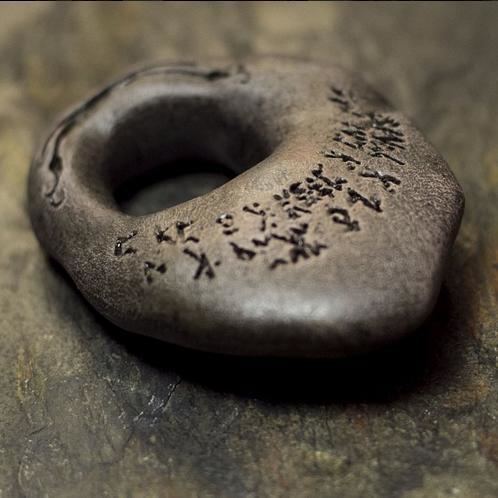 | ||
Adder stone by jo quail
An adder stone is a type of stone, usually glassy, with a naturally occurring hole through it. Such stones have been discovered by archaeologists in both Britain and Egypt. Commonly, they are found in Northern Germany at the coasts of the North and Baltic Seas.
Contents
- Adder stone by jo quail
- Adder stone hunting march 28th 2014
- The Druids
- In Welsh mythology
- In Irish mythology
- In Russian Mythology
- References

In Britain they are also called hag stones, witch stones, serpent's eggs, snake's eggs, or Glain Neidr in Wales, milpreve in Cornwall, adderstanes in the south of Scotland and Gloine nan Druidh ("Druids' glass" in Scottish Gaelic) in the north. In Egypt they are called aggry or aggri.

Adder stones were believed to have magical powers such as protection against eye diseases or evil charms, preventing nightmares, curing whooping cough, the ability to see through fairy or witch disguises and traps if looked at through the middle of the stone, and of course recovery from snakebite. According to popular conception, a true adder stone will float in water.

Three traditions exist as to the origins of adder stones. One holds that the stones are the hardened saliva of large numbers of serpents massing together, the perforations being caused by their tongues. The second claims that an adder stone comes from the head of a serpent or is made by the sting of an adder. The third is more modern (and much easier to attain). It details that the stone can be any rock with a hole bored through the middle by water. Human intervention (i.e., direction of water or placement of the stone) is not allowed.

Adder stone hunting march 28th 2014
The Druids
Adder stone was held in high esteem amongst the Druids. It was one of their distinguishing badges, and was accounted to possess the most extraordinary virtues. There is a passage in Pliny’s Natural History, book XXII, describing the nature and the properties of this amulet. The following is a translation of it:
"There is a sort of egg in great repute among the Gauls, of which the Greek writers have made no mention. A vast number of serpents are twisted together in summer, and coiled up in an artificial knot by their saliva and slime; and this is called "the serpent's egg". The druids say that it is tossed in the air with hissings and must be caught in a cloak before it touches the earth. The person who thus intercepts it, flies on horseback; for the serpents will pursue him until prevented by intervening water. This egg, though bound in gold will swim against the stream. And the magi are cunning to conceal their frauds, they give out that this egg must be obtained at a certain age of the moon. I have seen that egg as large and as round as a common sized apple, in a chequered cartilaginous cover, and worn by the Druids. It is wonderfully extolled for gaining lawsuits, and access to kings. It is a badge which is worn with such ostentation, that I knew a Roman knight, a Vocontian, who was slain by the stupid emperor Claudius, merely because he wore it in his breast when a lawsuit was pending."Huddleston's edition of John Toland's "History of the Druids" gives some very ingenious conjectures on the subject of this very enigmatical Druids' egg. The amulets of glass and stone, which are still preserved and used with implicit faith in many parts of Scottish Gaeldom, and are conveyed, for the cure of diseases to a great distance, seem to have their origin in this bauble of ancient priestcraft.
In Welsh mythology
The Glain Neidr or Maen Magi of Welsh folklore is also closely connected to Druidism. The Glain Neidr of Wales are believed to be created by a congress of snakes, normally occurring in spring, but most auspicious on May Eve.
Although not named as Glain Neidr, magic stones with the properties of adder stones appear frequently in Welsh mythology and folklore. The Mabinogion, translated into English in the mid-nineteenth century by Lady Charlotte Guest, mentions such stones on two occasions. In the story of Peredur son of Efrawg (Percival of the Arthurian cycle), in a departure from Chrétien de Troyes' Perceval, the Story of the Grail, Peredur is given a magical stone that allows him to see and kill an invisible creature called the Addanc. In another tale, Owain, or the Lady of the Fountain (Ywain of Arthurian legend), the hero Owain mab Urien is trapped in the gatehouse of a castle. He is given a stone by a maiden, which turns Owain invisible, allowing him to escape capture.
In Irish mythology
While serpents, not being present in Ireland do not often feature in Irish mythology other creatures can form parallels. The legendary druid Mug Ruith was said to have a stone which could turn into a poisonous eel when thrown in water, this may be a reference to a Adder Stone.
In Russian Mythology
In Russian folklore, adder stones were believed to be the abodes of spirits called Kurinyi Bog ("The Chicken God"). Kurinyi Bog were the guardians of chickens, and their stones were placed into farmyards to counteract the possible evil affects of the Kikimora (The wives of the Domovoi, the house spirits.) Kikimora, who also guarded and took care of chickens, could often unleash misery upon hens they did not like by plucking out their feathers.
